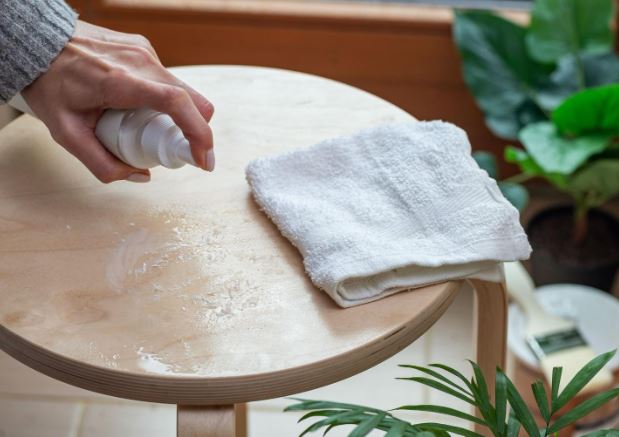We’ve all been there – a spill or accident leaves behind an unwelcome sight on our furniture. Whether it’s at home or in a hotel, seeing stains on fabric can be especially disheartening. With so many possible scenarios, it seems difficult to know where to start when attempting to remove the stain. Fortunately, we have got you covered! In this blog post, we are going to delve into how you can remove six of the most common stains from your furniture.
We’ll take a comprehensive approach and cover everything from how to spot each type of stain, what tools you will need for successful cleaning, and – finally – exactly how to wipe away the mark that was causing your stress. From soda spills to pet messes and beyond, get ready for some useful tips on tackling even the toughest spots!
1. Wine:
To remove red wine stains from upholstery, begin by blotting the area with a paper towel or clean cloth. Make sure to use only enough pressure to absorb the liquid without pushing it further into the fabric’s fibers. Next, create a mixture of equal parts vinegar and water and apply it to a new cloth before using it to scrub away any remaining residue from the stain. Finally, let the fabric air dry and vacuum when done. You can also use a carpet or upholstery cleaner if the stain persists.
2. Coffee:
To remove coffee stains from upholstery, start by blotting with a paper towel or clean cloth to absorb as much of the liquid as possible. Then, mix together one part vinegar and two parts warm water and apply it to the stain using a cloth. Scrub lightly in small circles to lift the coffee residue from the fabric fibers before rinsing with warm water. Finally, let the fabric air dry and vacuum when done. If you have any remaining discoloration, you can use an upholstery shampoo for the best results. To prevent coffee stains in the future, you can use a fabric protector or a light coating of beeswax.
3. Pet Messes:
To get rid of pet messes on furniture upholstery, begin by blotting with paper towels or a clean cloth to absorb as much liquid as possible. Then, mix together one cup of warm water and 1/4 teaspoon of dishwashing detergent before applying it to the stain with a sponge. Scrub lightly in small circles and rinse with warm water before letting the fabric air dry. For tougher pet messes, you may need to apply an enzyme cleaner meant for pet stains. Finally, vacuum when done. If you feel that your upholstery has lost its charm then consider hiring PRO Upholstery Cleaning to clean the mess completely.
4. Crayon:
Start by scraping away any excess crayons from the upholstery fabric. Next, blend together one cup of warm water and 1/4 teaspoon of dishwashing detergent before dabbing on the stain with a sponge. Work in a circular motion, and make sure not to rub too hard. Blot with a clean cloth or paper towel until gone. If needed, you can use rubbing alcohol or WD-40 to remove any remaining residue. Vacuum afterward to finish up.
5. Ketchup:
When dealing with ketchup stains, begin by blotting the area with a damp cloth. You can mix one tablespoon of vinegar and 1/4 teaspoon of dishwashing detergent in a cup of warm water before applying it to the stain with a sponge. Rinse off with cold water afterward and pat dry using paper towels or a clean cloth. Another option is to apply a small amount of rubbing alcohol onto the spot, then blot it with a damp cloth. Finally, vacuum the area when finished.
6. Gravy:
Gravy stains can be particularly tricky, so it is important to act fast. Start by blotting the spot with a damp cloth. Then mix one tablespoon of vinegar and 1/4 teaspoon of dishwashing detergent in a cup of warm water before applying it to the stain with a sponge. Rinse off with cold water afterward and pat dry using paper towels or a clean cloth. For tougher spots, you can use rubbing alcohol or WD-40 to remove any remaining residue. Vacuum afterward to finish up. You can also use a stain remover spray to pre-treat the area before beginning.
7. Ink:
Ink stains can be especially tricky to remove as they tend to set quickly. Start by blotting the spot with a damp cloth, then use rubbing alcohol or acetone-free nail polish remover on a cotton swab and dab it onto the ink stain until it is gone. If you have any residue left behind, try using an enzyme detergent or laundry pre-treater before washing it in cold water. Lastly, vacuum the area when finished.
8. Coffee & Tea:
For coffee or tea stains, you will want to act swiftly to prevent the stain from setting. Blot up as much of the liquid as possible with a dry cloth, then mix 1 teaspoon of dishwashing liquid with 1 cup of warm water and sponge onto the spot. Use a cloth dampened with clean water to rinse off any residue and blot away excess moisture. Again, if there are stubborn spots remaining, try using an enzyme detergent or laundry pre-treater before washing in cold water. Vacuum once done.
9. Pet Messes:
Accidents happen – even at home! For pet messes, start by scraping away any solids from the area, then use a sponge and cold water to remove as much of the stain as possible. Next, mix 1/4 cup vinegar with a quart of warm water and sponge it onto the spot. Rinse the area with a cloth dampened in clean water and blot up excess moisture. If there are still some traces of the pet mess remaining, consider using an enzyme detergent or laundry pre-treater before washing in cold water on a gentle cycle. Vacuum once done.
10. Soda Spills:
For soda spills, start by sponging away any leftover residue from the area using cold water and blotting up how to remove any excess moisture. Next, mix 1/4 cup dish soap with 2 cups warm water and apply to the spot using a sponge. Then, rinse again with cold water and blot up how to remove any excess moisture once more. Repeat if needed until the stain has been effectively removed.
Conclusion:
No matter how daunting the stain may seem, tackling it can be easier than you think. With the right knowledge and tools, removing even the worst of stains from upholstery is possible! Remember to spot-test any cleaning solution first and always work your way from mildest to strongest when trying to remove a stain. We hope these tips have been helpful for the removal of common stains on your furniture – good luck!





